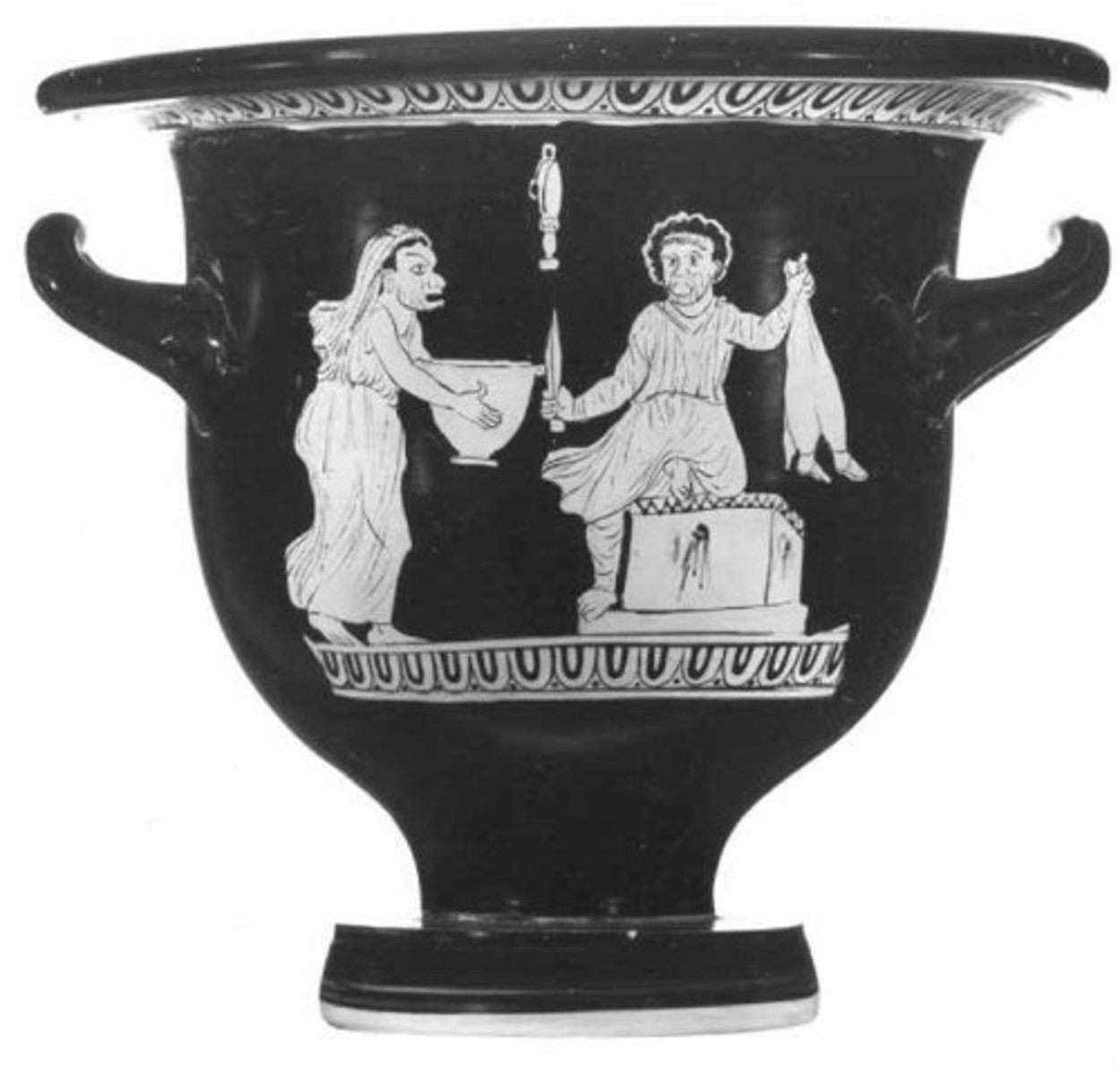Drama and Theatre in Ancient Athenian Society
1/47
There's no tags or description
Looks like no tags are added yet.
Name | Mastery | Learn | Test | Matching | Spaced |
|---|
No study sessions yet.
48 Terms
What is the ancient greek idea of the 'theatre of the mind?'
Greek theatre relied on daylight, acoustics and the suspension of disbelief.
When was theatre born?
2 ½ of 6 century BC in West Athens. Preformed at religious festivals
What was a polis?
the city and the surrounding region. For Athens, it included the city and the surrounding area of Attica.
What was a Dithyramb?
A choral dance in honour of Dionysus, invented by Arion, reportedly where drama evolved from
What are the 3 important religious festivals?
1. The Lenaia- Held in late January, meaning it was only for the polis as the seas were too rough to travel. There were both comedy and tragedy competitions, but comedy seemed to be more important. Where Frogs was preformed
2. The Rural Dionysia- Held in mid-winter. Most like revivals of the 2 main city events in the rural Attican demes.
2. City Dionysia- Held in late March, although preparations started the summer prior, for the reopening of the sea lane so other Greeks could see Athens showing off. Also, for the growth of a new spring, as Dionysus was the god of growth. The largest of the three events.
How many synopses did tragic and comic playwriters have to present for the City Dionysia, and how many writers did the eponymous archon select?
Tragic playwrights had to give 4 synopses, with 1 being a satyr play. Comedic writers had to give 1 synopsis. The eponymous archon selected 3 tragic playwrights and 5 comedic ones.
Who was the eponymous archon and what did he do?
A leading political figure in Athens who ran City Dionysia and had to select the choregos
Who were the choregos and what did they do?
- The financial banker to support to playwright and the playwrights play. They were super wealthy and had to fund liturgies (the tax requiring the super-rich to fund the functioning of Athens)
- They selected the chorus, give them good, rehearsal spaces, and sometimes even accommodation/a professional trainer.
- A successful play meant prestige for the chorego, as if they won, they could pay for a victory monument with an inscription of his name, the eponymous archons', the main actors and the musicians.
How much did the City Dionysia cost and when was the Theoric Fund introduced
- It cost a day wage for an unskilled worker to gain entry.
- In the 2nd ½ of the 5th century, The Theoric Fund was established (the Athenian state paid for the poor to go).
Who were the front seats in the City Dionysia for, and how was the rest of the seating arranged?
- Important officials like the priest of Dionysus.
- By the late 4th century, the seating area allowed for the tribes to sit together, but it's unclear if women could go.
- The audience was pretty loud, thus there were rod-bearers to keep things under control.
What happened 1-2 days before the City Dionysia?
-The Proagon, held in the Odeion
the plays were announced with the playwright's synopsis, possibly an intro from the chorego, actors and musicians. The actors might have given a taster, which would have been the only time actors appeared as characters without a mask)
What happened the evening before the City Dionysia?
-Torchlit procession with a wooden statue re-enacting Dionysus' arrival to Athens from the deme of Eleutherae
- In the Theatre of Dionysus there's a sacrifice and that's where the statue stays.
- In the latter half of the 5th century, lots were drawn to determine the order of the plays.
What happened on day 1 of the City Dionysia?
- The pompe (the grand procession).
Started outside the city then went to the agora (open space for meeting), then to the Temple of Dionysus where a sacred bull and other animals were sacrificed.
- In the afternoon there was a dithyramb with each of the tribes, one made of 50 boys and one made of 50 men. Each chorus had it's own choregos.
- In the evening there was the komos (loosely organised revel throughout the streets with song and dance)
What happened on day 3 and 4 of the City Dionysia?
Day 3: 3 tragedies, 1 satyr-play
Day 4: 3 tragedies, 1 satyr-play
What happened on day 2 of the City Dionysia?
- Grand opening ceremony in Theatre of Dionysus with a sacrifice in the acting area to Dionysus and 10 generals pour libations to the Olympian gods.
- The Parade of Tribute
- The Proclamation of Honours (Harald announced the names of those who deserved a shout out and they got a crown)
- The Parade of Orphans (boys whose dads dies in war were paraded around. The state paid for their education and at 18 they got a suit of armour and were declared an independent citizens).
- All 5 comedies followed this.
What happened on day 5 of the City Dionysia?
- 3 tragedies, 1 satyr-play
- The judging.
Pre-festival the Athenian council would draw up a list of names from each tribe and they were sealed in 10 urns on Acropolis (a fortified bit of the city). On the 1st day the eponymous archon drew out the names and the men swore to be impartial. 5th day they wrote down best to worst and put them in an urn. Half of the tablets were chosen and whoever got the most votes won.
- Prize-giving
What happened a couple days after the City Dionysia?
- The review.
The Athenian assembly met in the Theatre of Dionysus. Any citizen could make a complaint and if it was upheld the archon could be fined. If not, a vote to give the archon a crown could be made.
What was the theatron?
- The watching area, usually on a hillside so everyone could see (see the Theatre of Dionysus).
- In a Lycurgan Theatre it was in a semi-circle shape with 13 wedges.
- The front was called the prohedria and was for people of import, such as officials.
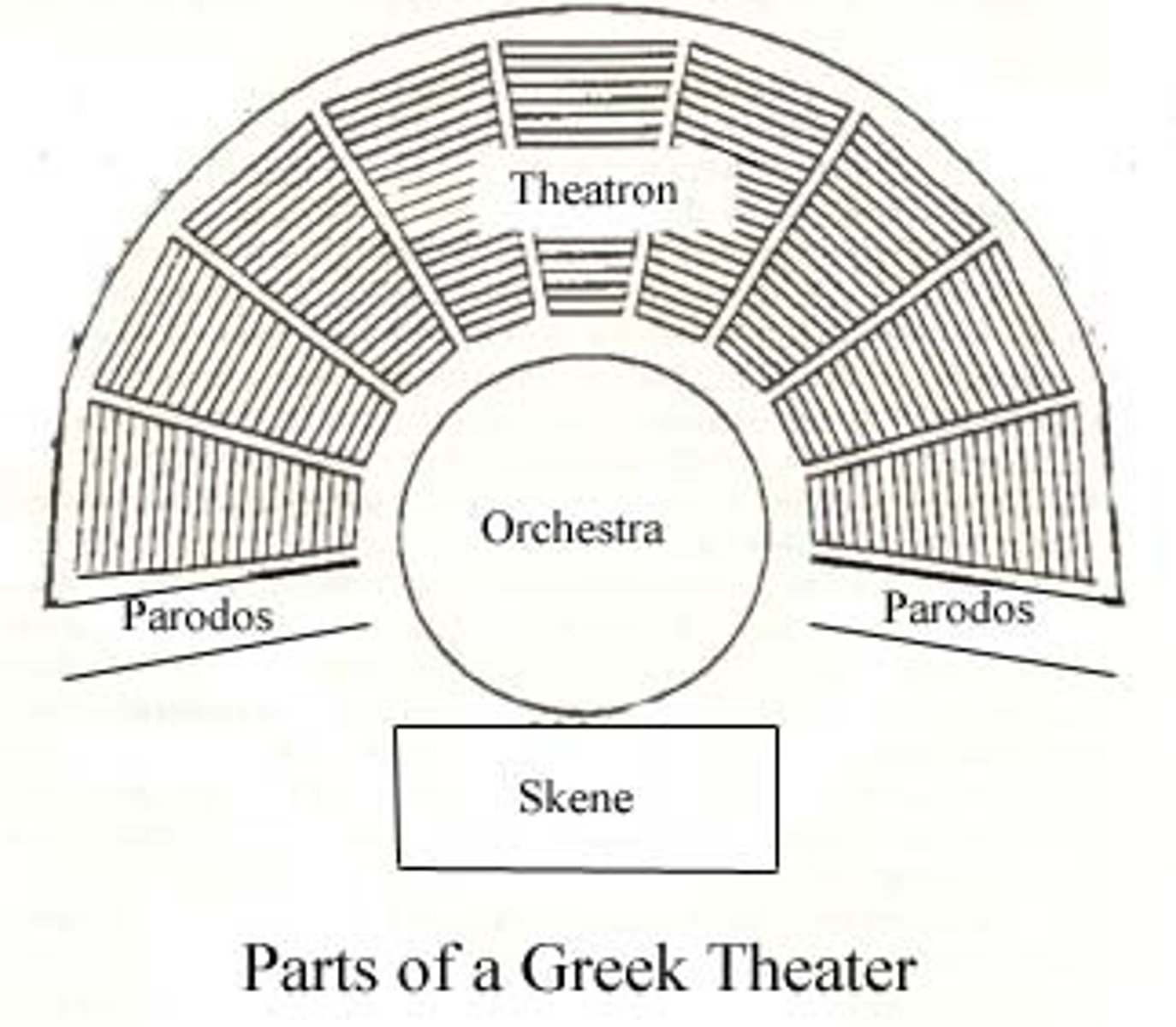
What was the orchestra?
- The dancing area, where the chorus was
- At the front of the theatron, with eisodos/parodos on each side so the chorus and spectators could get in and out.
- It's possible there's an alter to Dionysus near here.
- In Lycurgan Theatre it was a circle with seats wrapped around the front half, in the 5th century it was probably a rectangle or trapezoid, as small deme theatres dating to this time have been excavated with this shape.
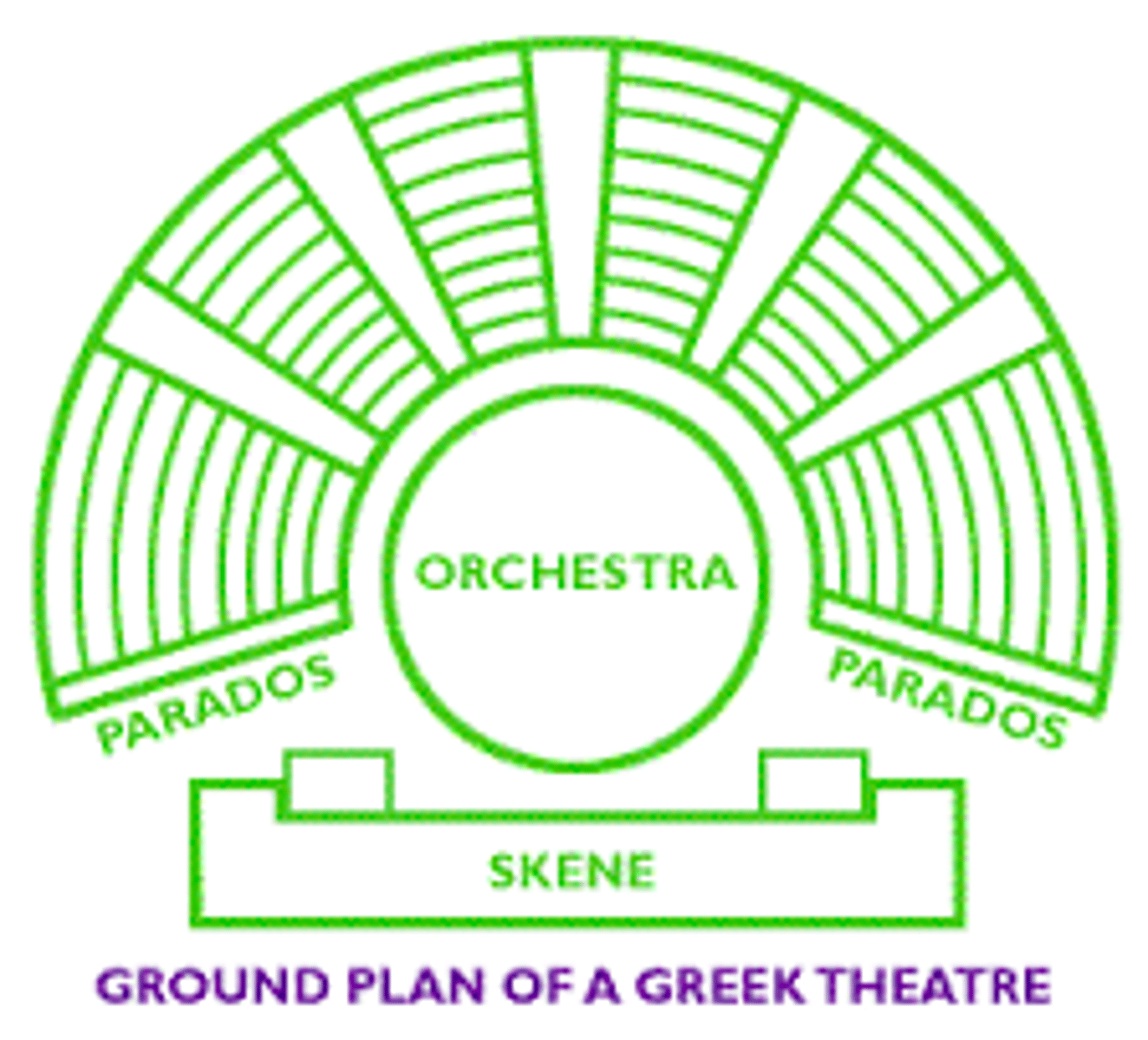
What's the date of the theatre of Dionysus?
- First built in stone in 320s BC.
- In use from the second half of the sixth century BC
- The remains of today are dated well after the 5th century
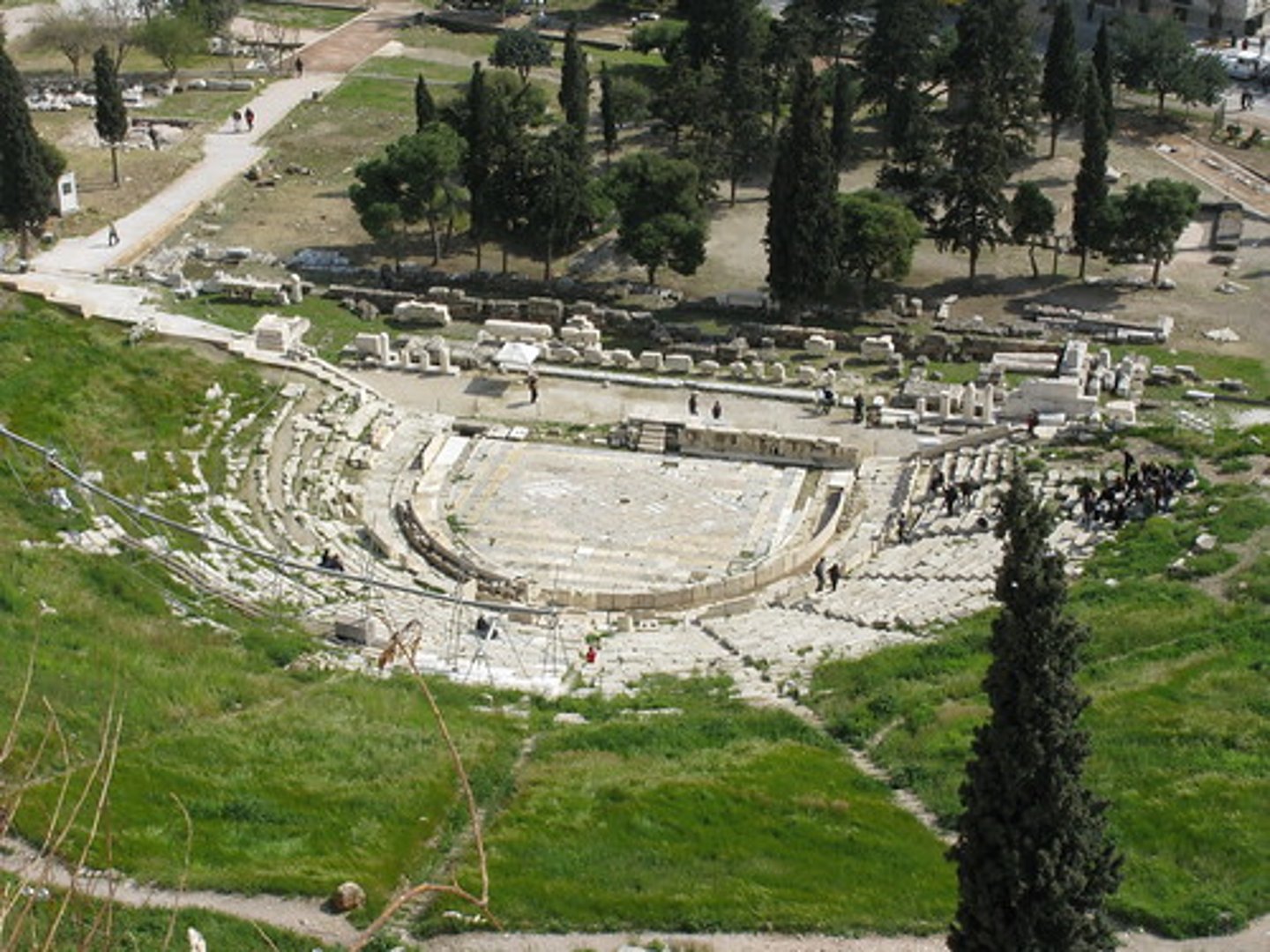
What's the location of the theatre of Dionysus?
- Athens
- It was the main theatre of Athens
- On the south-east side of the Acropolis. The Acropolis is the fortified part of the city, which is usually on a hill
- This meant that it was protected from the harsh north winter winds.
- It was also between the religious heart of the city and the sanctuary of Dionysus.
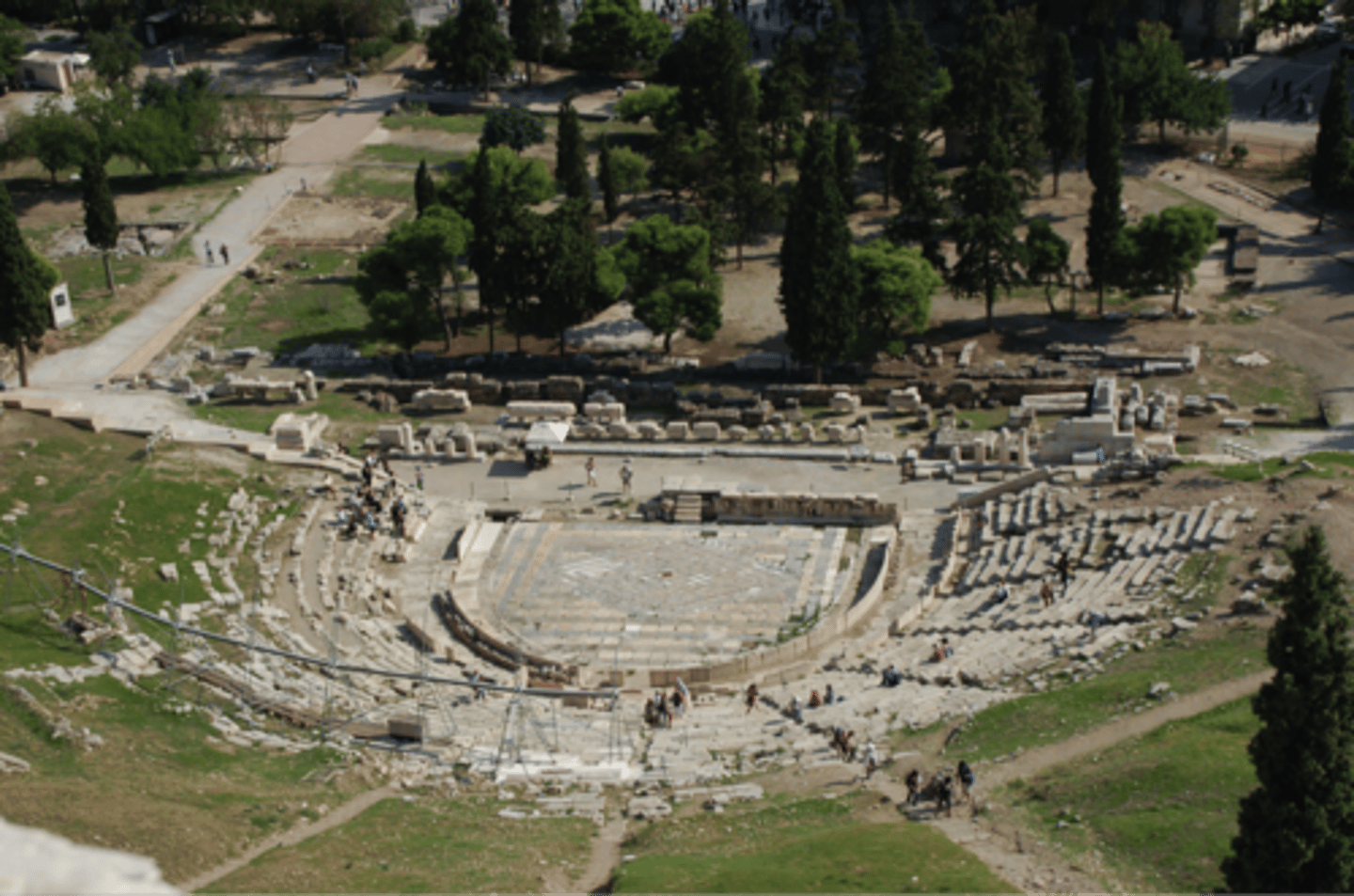
How did the theatre of Dionysus change over time?
- Under Lycurgus it had a capacity of around 17,000.
- It continued to be remodelled over time, notably in the 1st and 3rd century AD, because that was when Greece was under Roman rule.
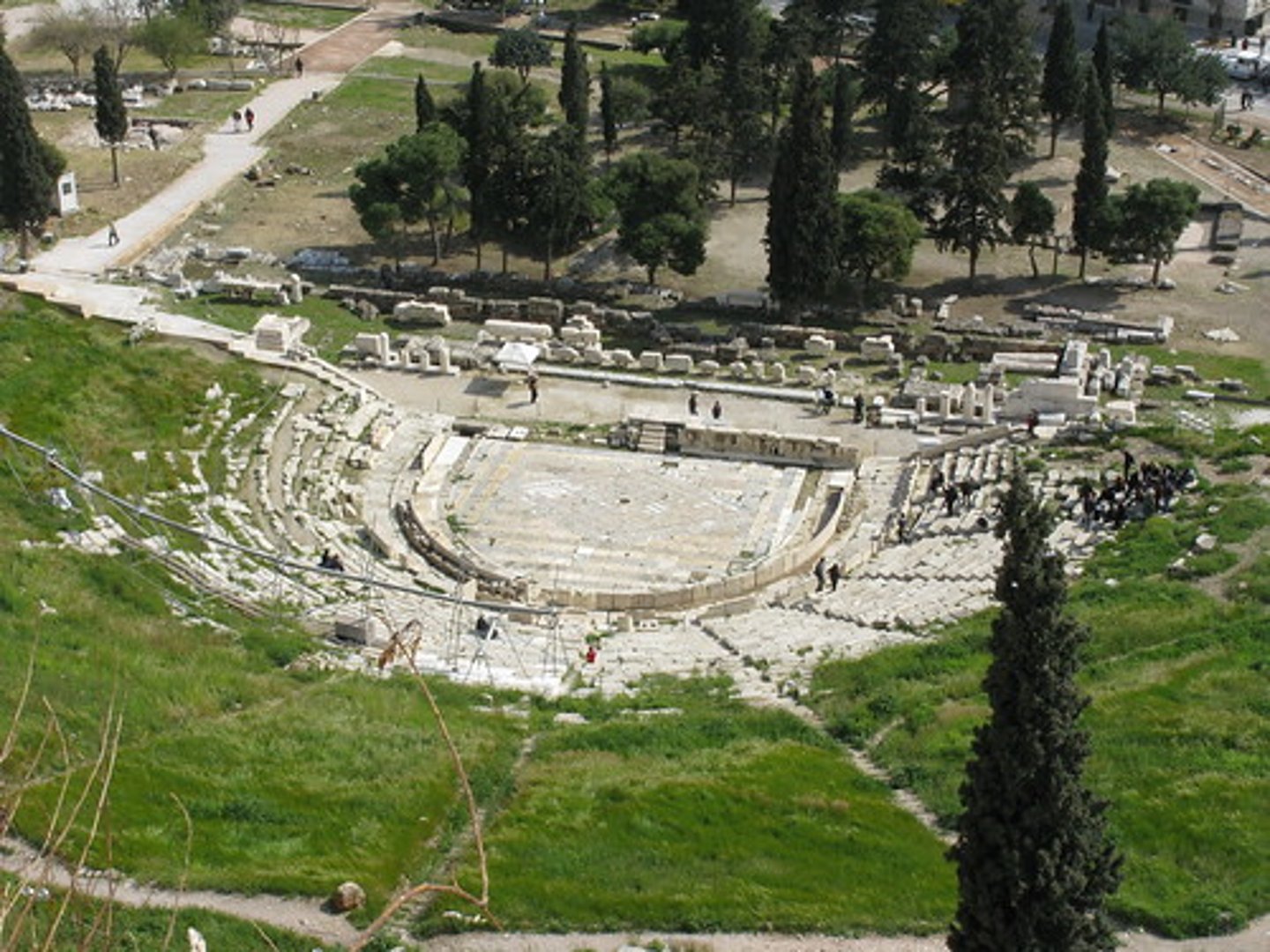
What's the significance of of the theatre of Dionysus?
- The main theatre of ancient Athens, and site of City Dionysia.
- One of the theatres we have left!
- The central seat was for the priest of Dionysus
- Evidence of the prestige given to drama was seen on the street which led from the theatre to the agora (market place) around the north and east side of the Acropolis. This was known as the street of Tripods, as bronze tripods were set up as victory monuments there.
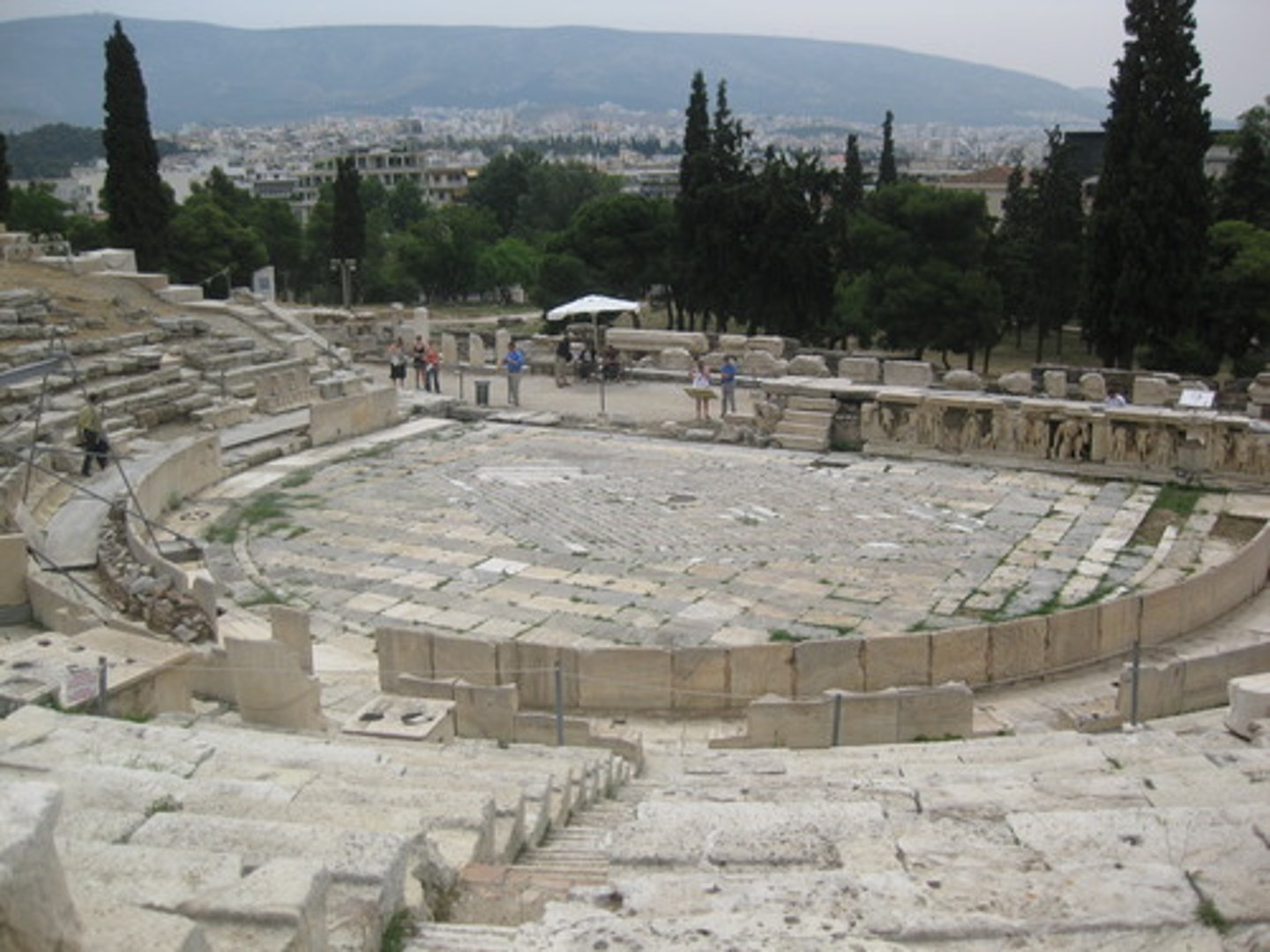
Who originally supervised the building of the theatre of Dionysus?
Lycurgus.
Thus, theatres of the mid/late 4th century BC are called Lycurgan theatre. He had a semi-circle threatron and circular orchestra
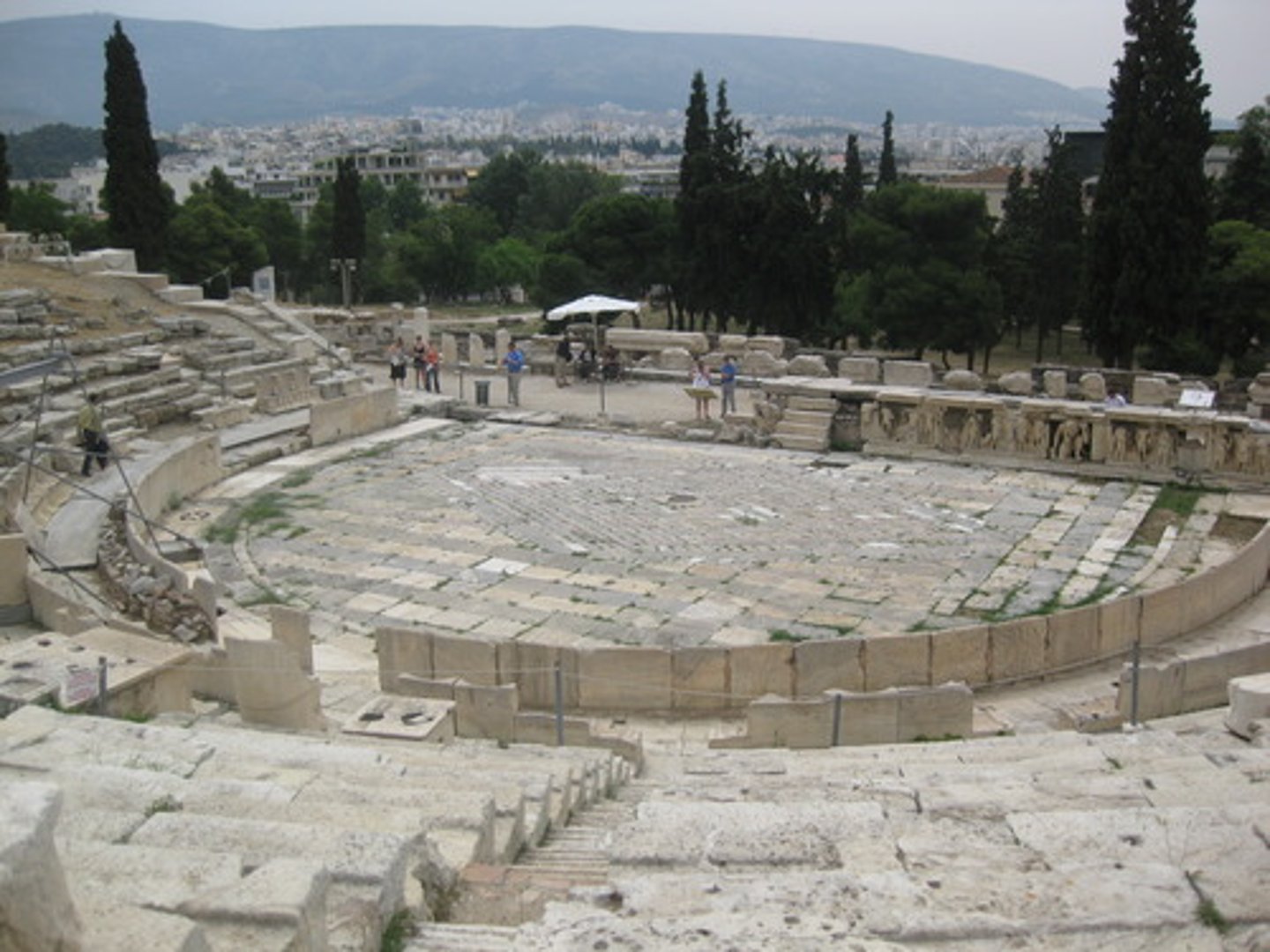
What's the date of the theatre of Thorikos?
late 6th/early 5th century BC
(the early period of Athenian drama)
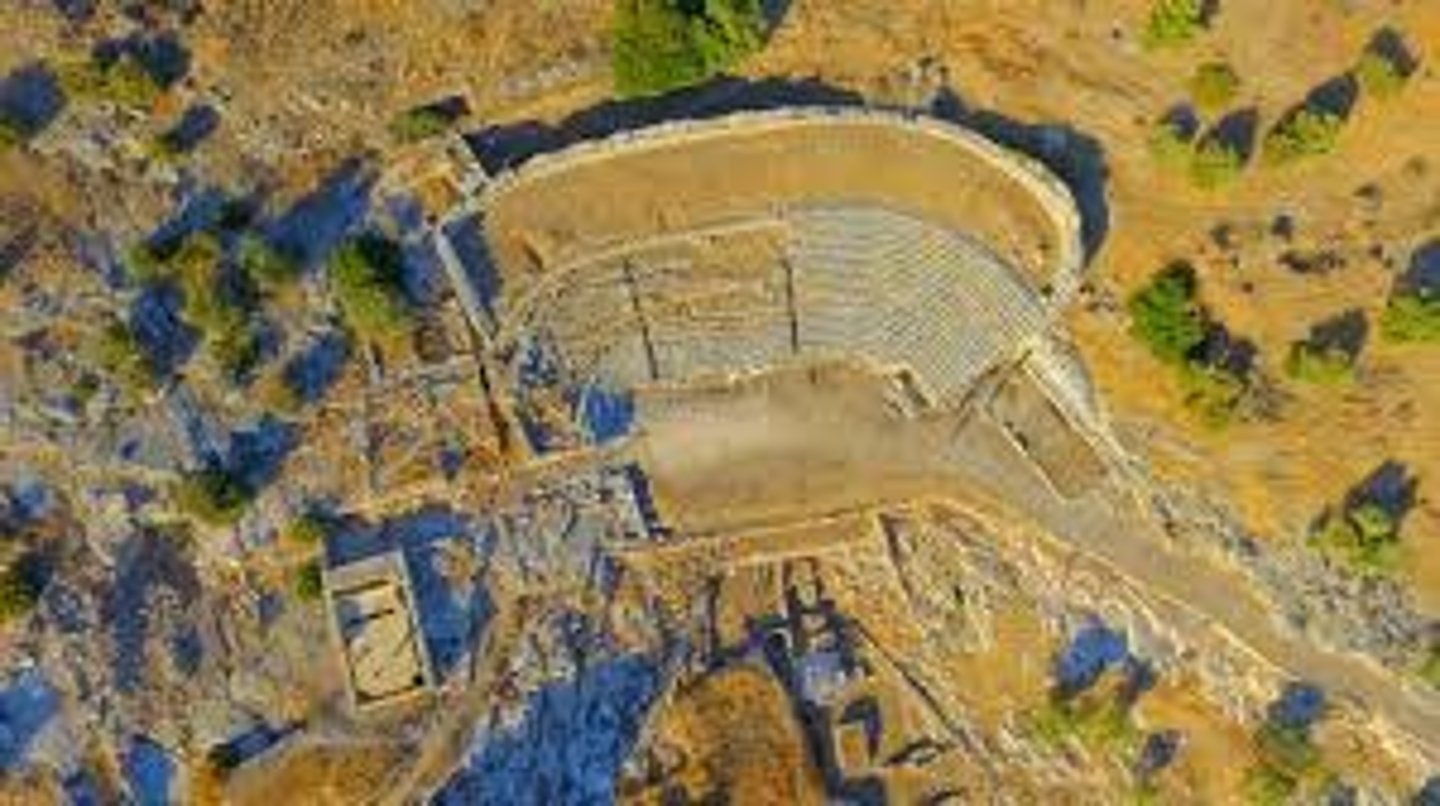
What's the location of the theatre of Thorikos?
- Thorikos!
- A deme on the south-east coast of Attica (Attica encompasses the city of Athens and its countryside)
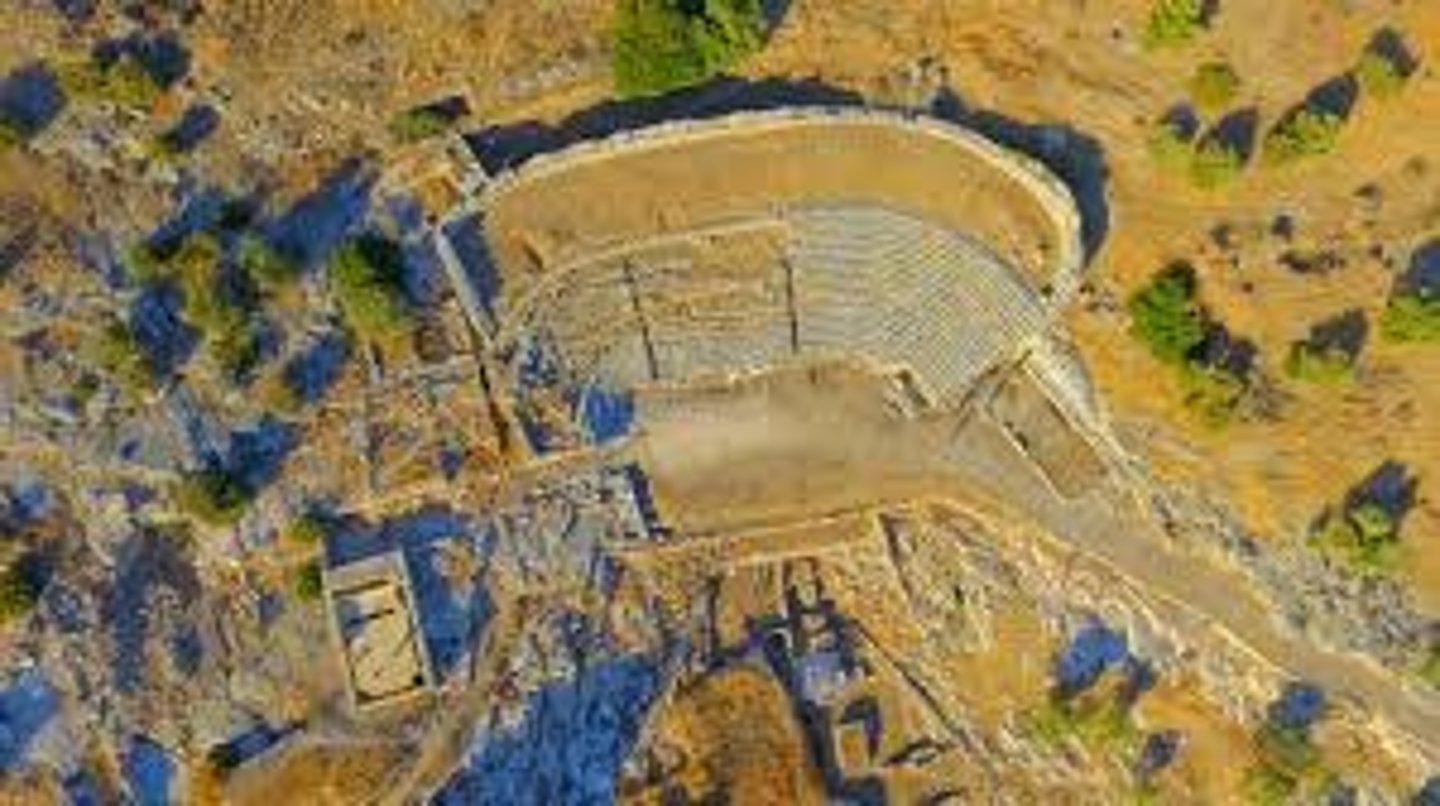
What's the significance/architecture of the theatre of Thorikos?
- A regional theatre of Attica which has a different lay out from the Theatre of Dionysus.
- It doesn't have a circular acting area, but a capacity of 3,000+ (which was large for a deme theatre).
- The theatron is mostly straight facing, with curved seating to either end.
- The orchestra is rectangular, temple and alter are at either end of the performance area.
- Very good acoustics and no trace of a skene, despite it being a main feature of the Theatre of Dionysus in the 5th century.
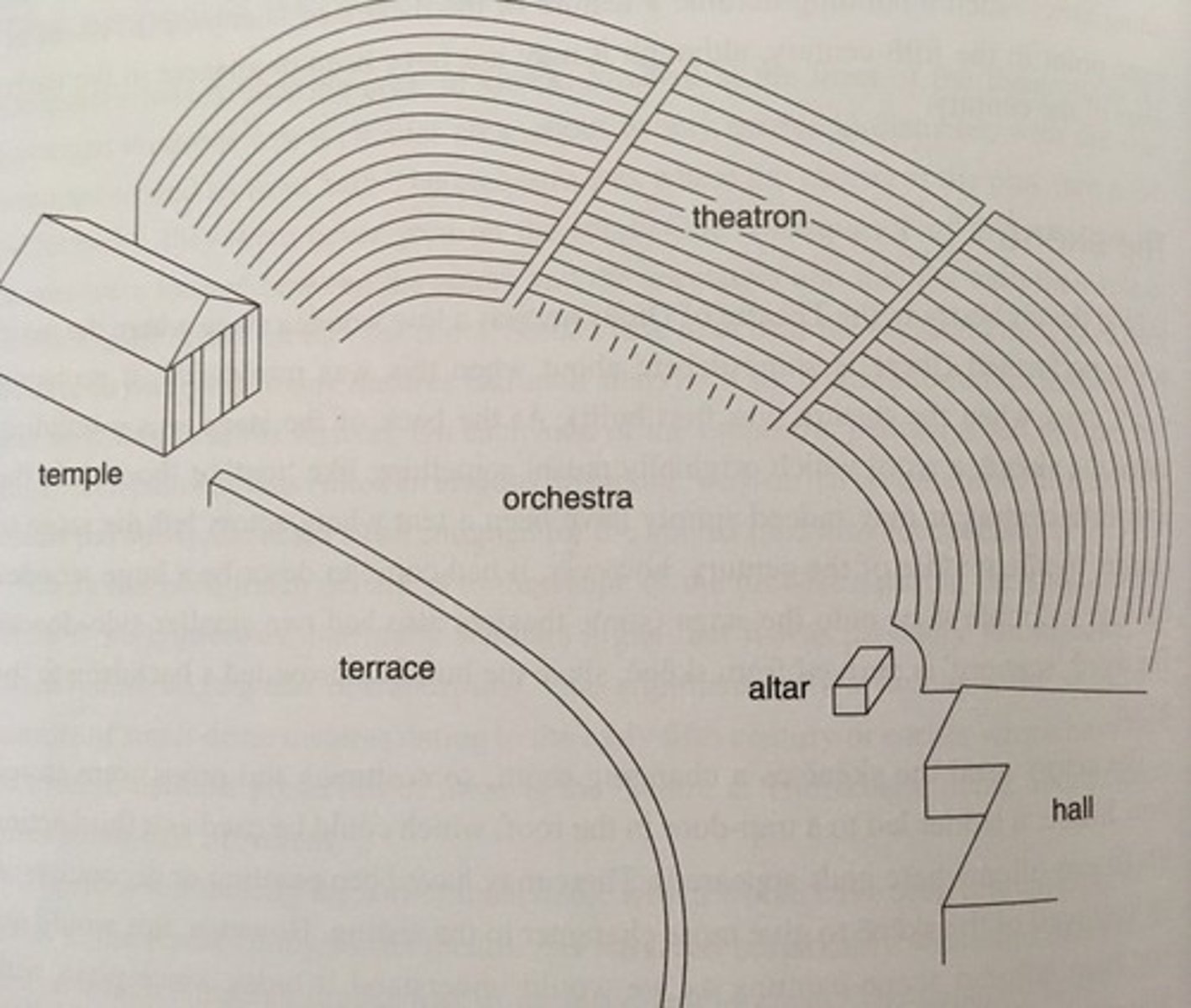
What is a skene and where was it located?
In the early 5th century, it may have been a changing tent, but by the mid-century it was a large wooden hut that was for changing and storage.
There was a ladder to the trap door in the roof for acting (usually for a god to appear)
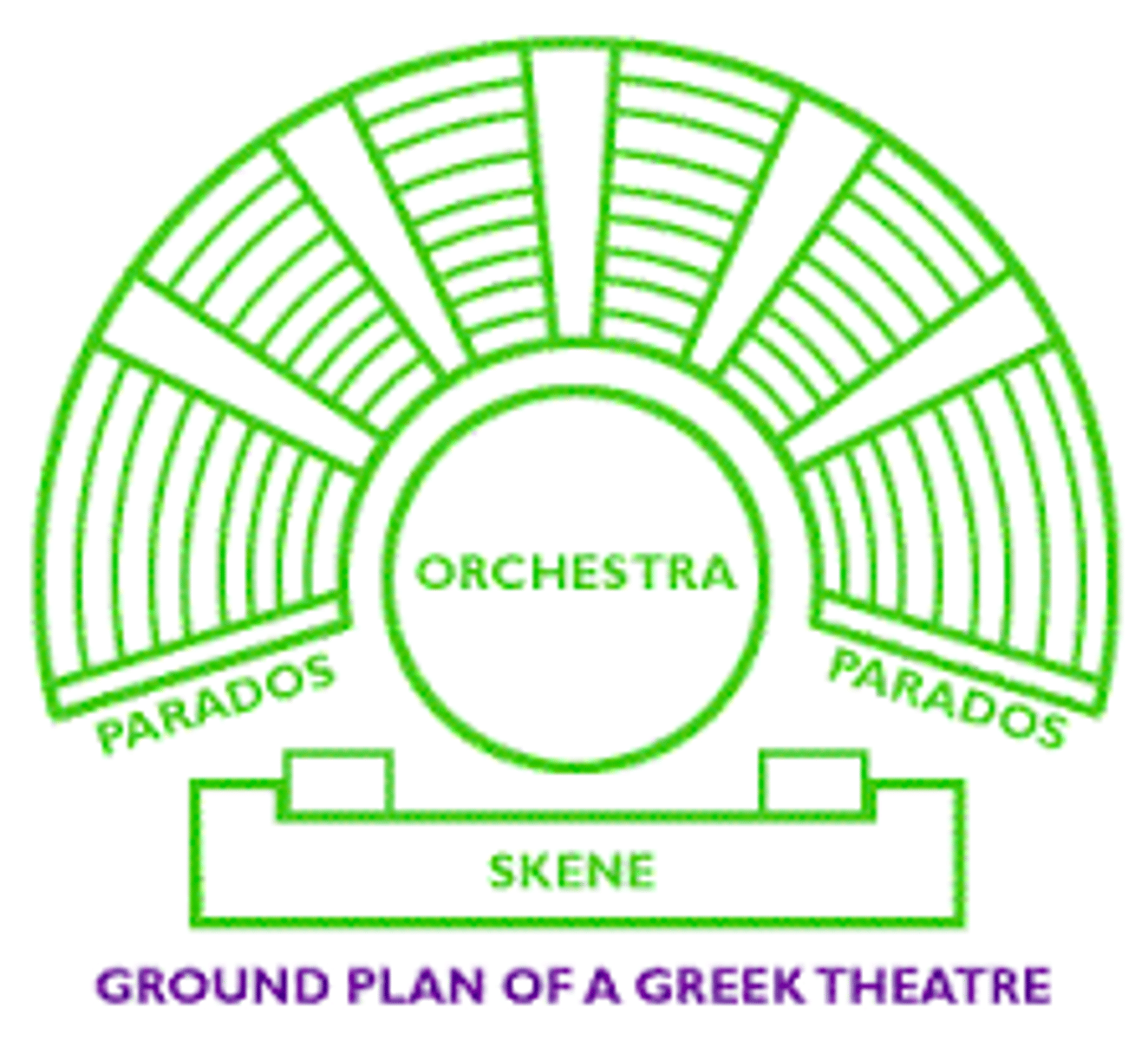
What type of object is 'the single actor (Perseus) and the 2 audience members/judges' prescribed source?
Attic red-figure chorus (wine-jug) vase fragment

Who is the artist of 'the single actor (Perseus) and the 2 audience members/judges' prescribed source?
Unknown

What is the location of 'the single actor (Perseus) and the 2 audience members/judges' prescribed source?
Vlastos Collection, Athens
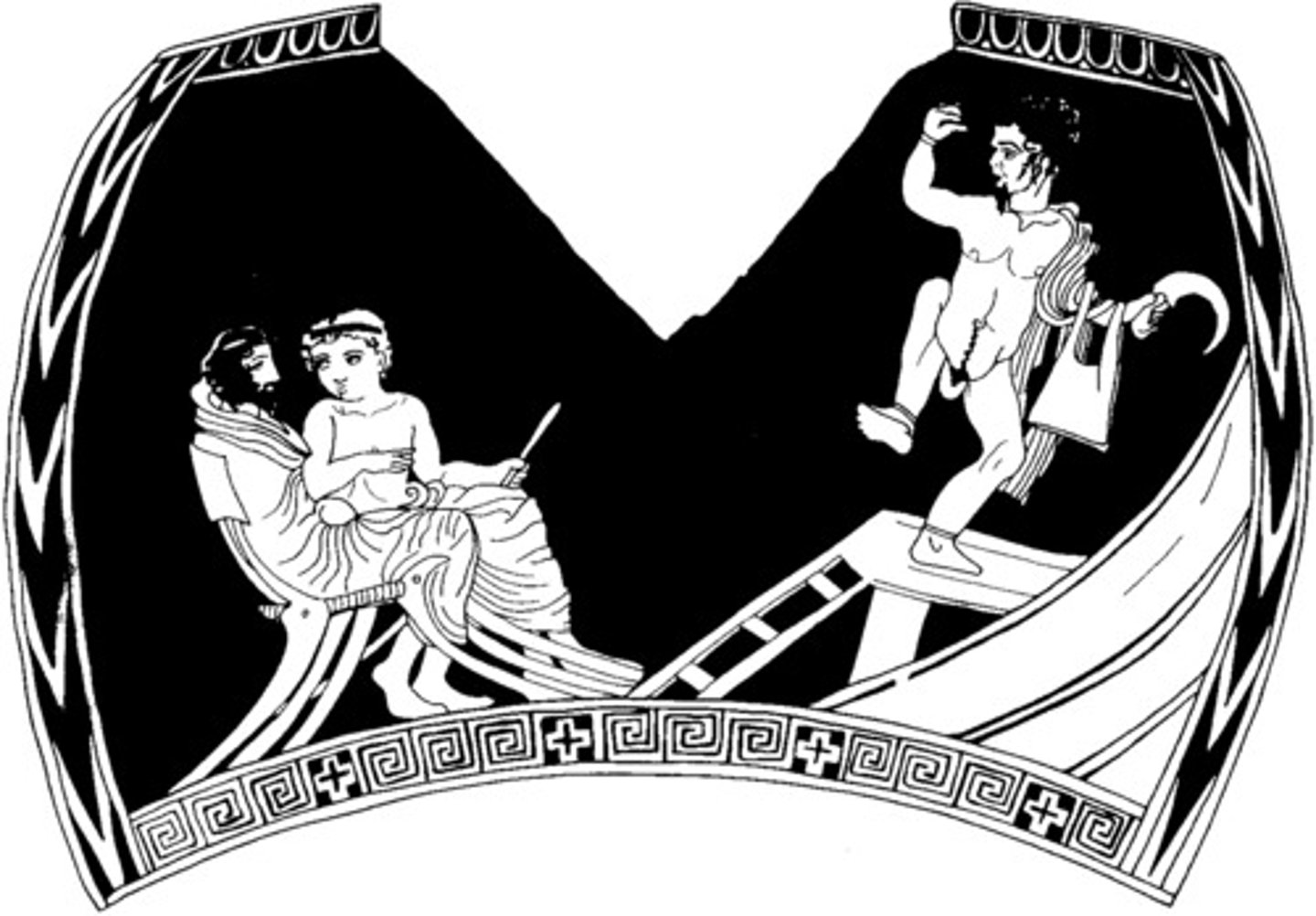
What is the date of 'the single actor (Perseus) and the 2 audience members/judges' prescribed source?
Around 420 BC
What is the significance of 'the single actor (Perseus) and the 2 audience members/judges' prescribed source?
- Only Attic vase where a stage is shown
- Only Greek vase to show an audience.
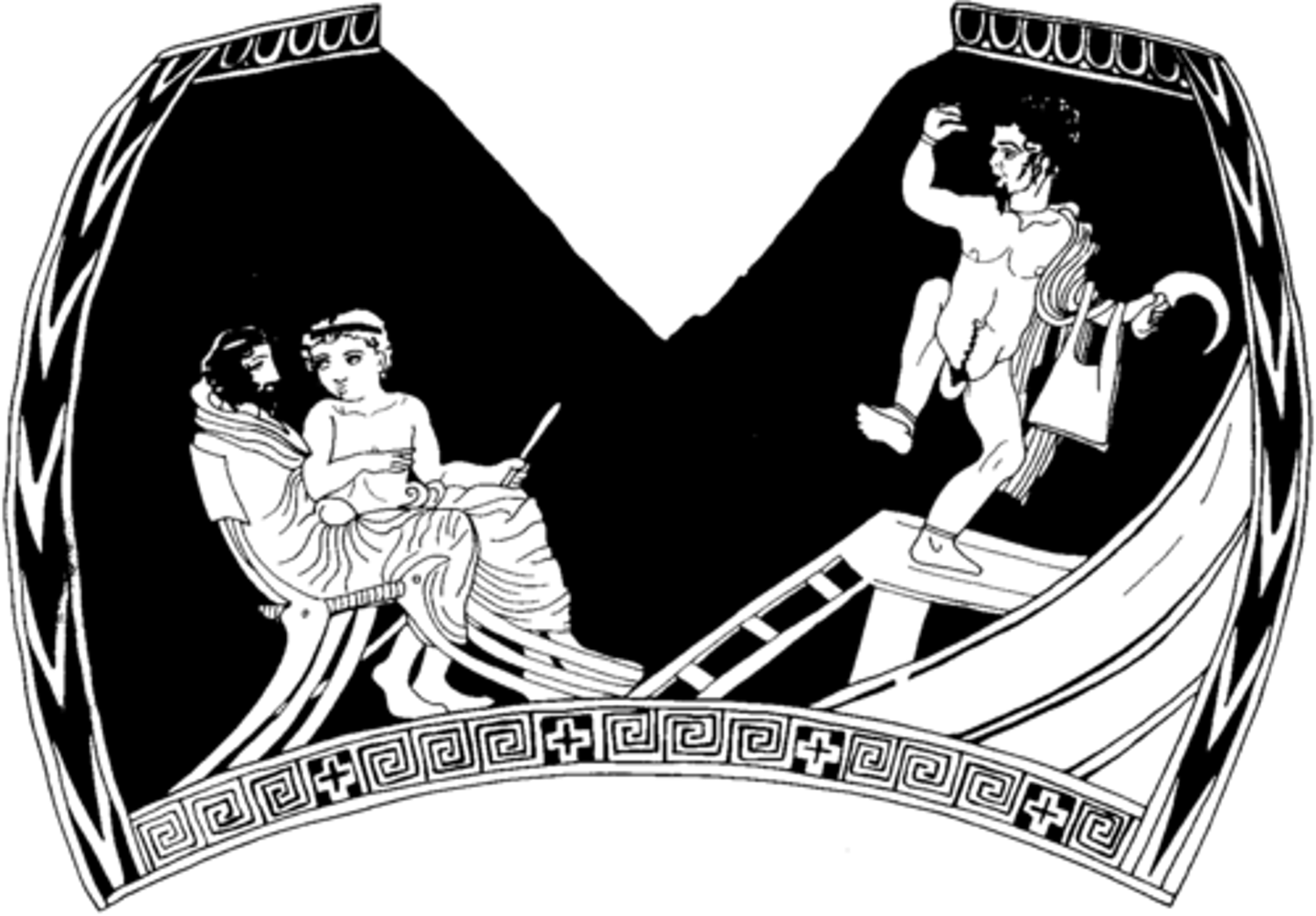
Description of 'the single actor (Perseus) and the 2 audience members/judges' prescribed source?
- There are reconstructed features as the vase was damaged and missing finer features.
- The comic actor could be Perseus, as he seems to be wearing a sickle to kill Medusa with, whose head is in a bag over his left arm.
- He's either dancing or pretending to fly like he does in the myth.
- The lines around his right wrist and feet show he's wearing a body suit- so he's not really naked.
- No mask, but there is a costume phallus tied around his legs.
- There's no orchestra, but 2 audience members, possibly interested to represent the rest of them. Both are wreathed, 1 is old with a beard and the other is younger (with an unclear gender).
- They're sitting on klismoi (elegant wooden chairs with a curved back), and those seats were often used for seating in the prohedria in Lycurgan theatre.
- They could be 2 judges, a priest of Dionysus and another priest, Dionysus and Ariade (his consort), or choregos and the playwright. It's unclear.
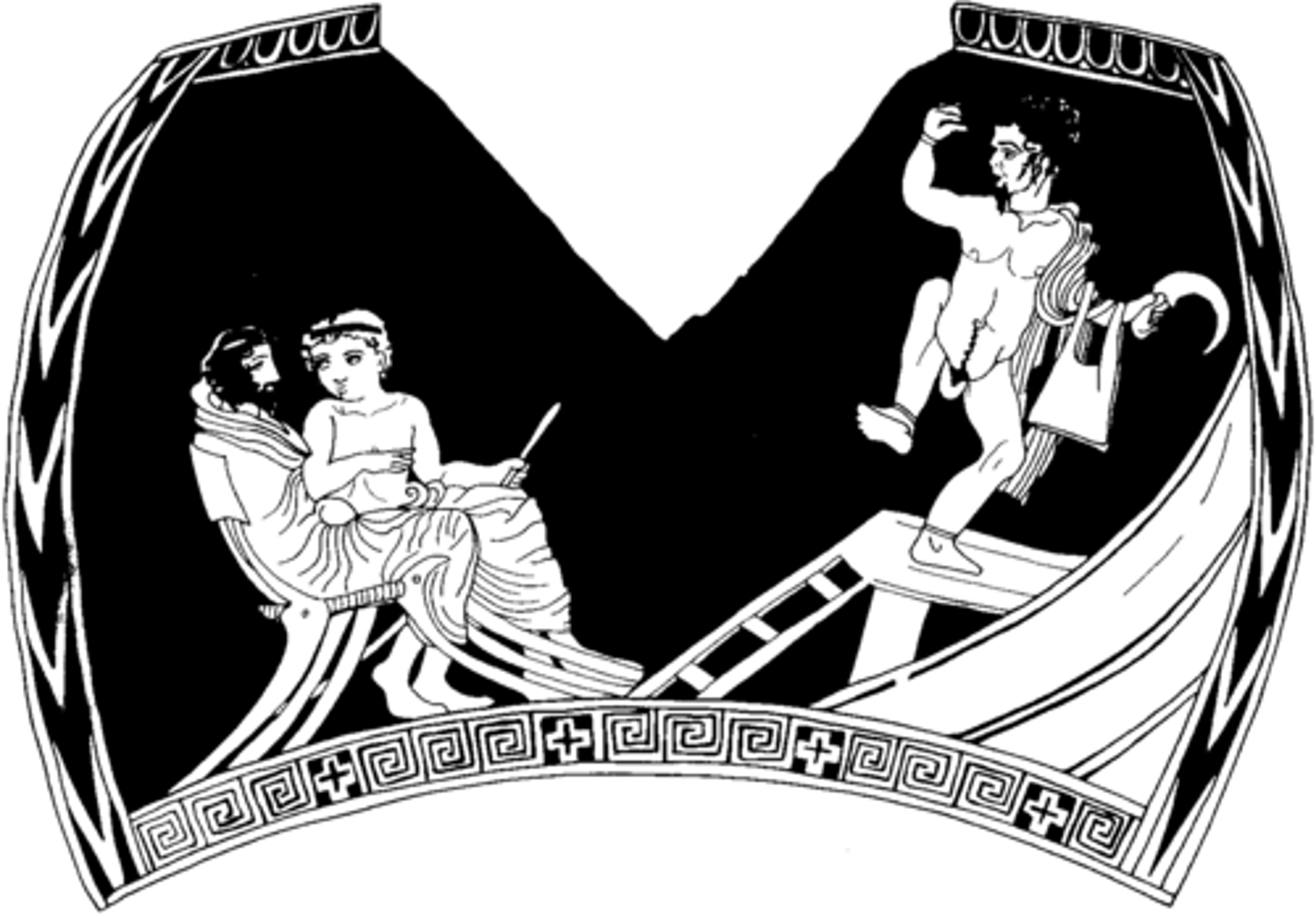
What were the 2 pieces of machinery that the Ancient Greeks used in theatre?
- The ekkyklema (the wooden platform)
a wooden platform on wheels brought out onto the stage through the main doors to portray a scene which happened indoors. In tragedy, it was for the body of a character who had died off stage.
- The secont (the crane)
a machine behind the skene to hoist characters in the air about the roof.
A vase predicted the use of these 2 pieces of machinery: The red-figure Calyx Krater depicting Medea's escape
What artist is credited with 'the red-figure Calyx Krater depicting Medea's escape' prescribed source?
The Policoro Painter
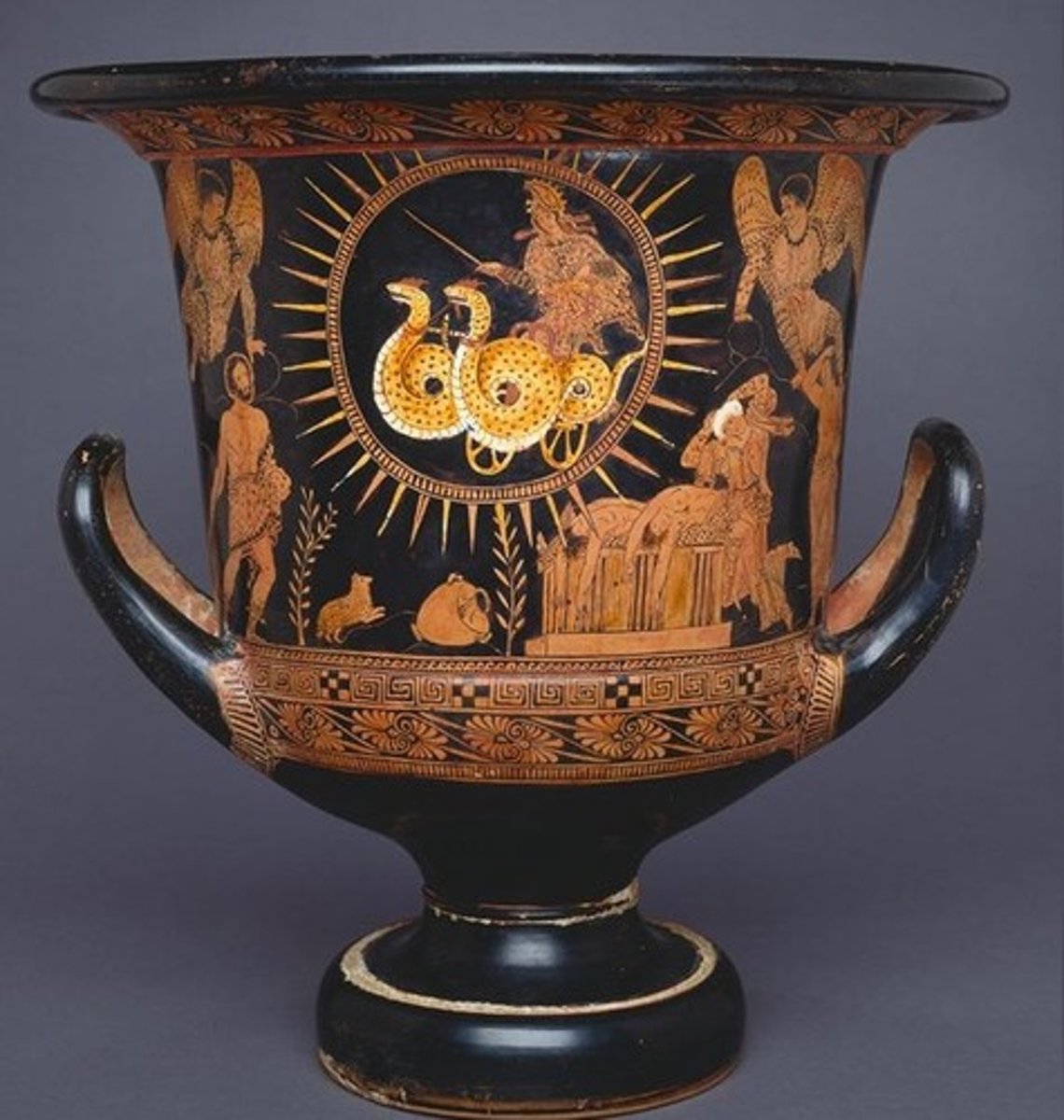
What kind of object is 'the red-figure Calyx Krater depicting Medea's escape' prescribed source?
A red-figure calyx krater (mixing bowl)
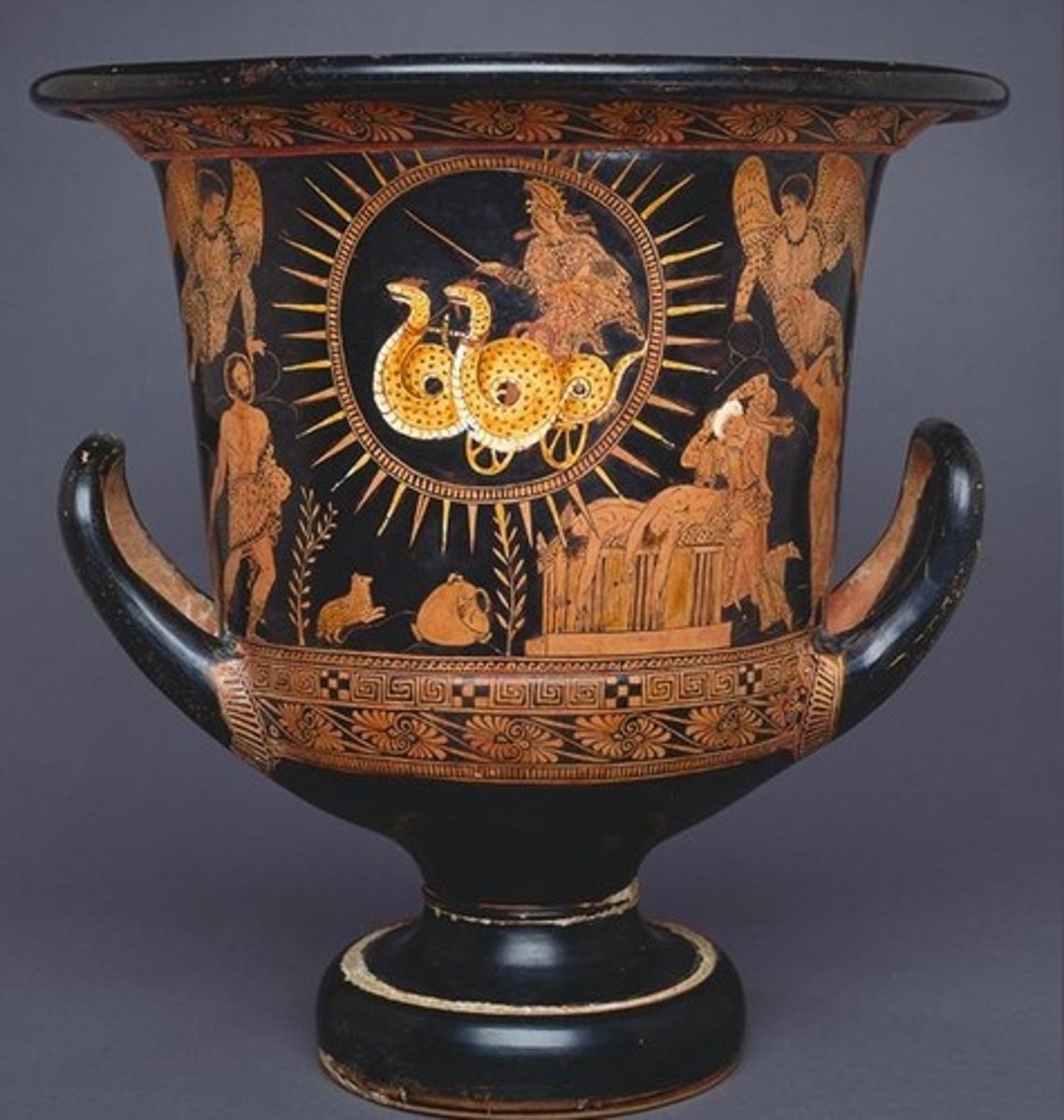
Where is 'the red-figure Calyx Krater depicting Medea's escape' prescribed source?
Cleveland Museum of Art
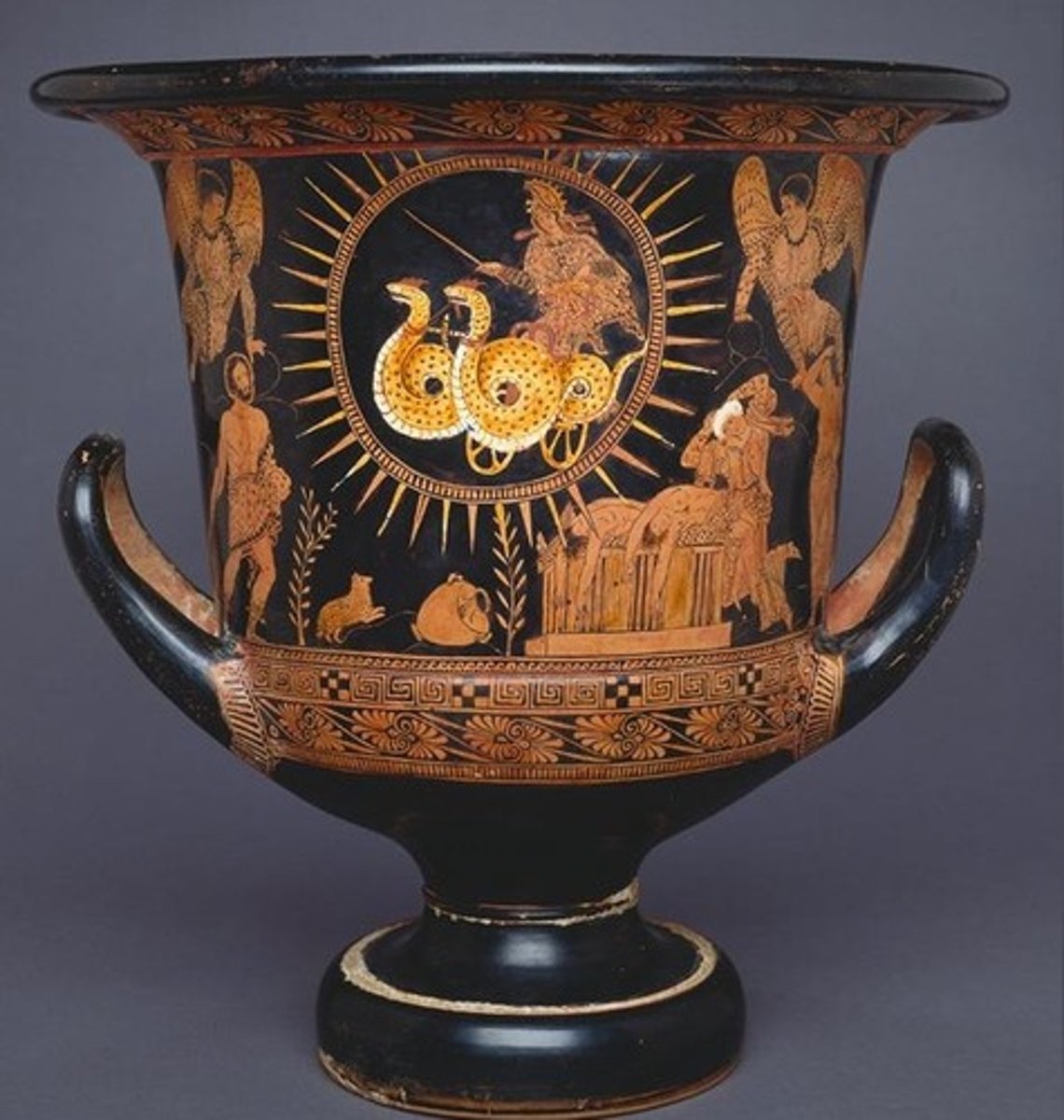
What's the date of 'the red-figure Calyx Krater depicting Medea's escape' prescribed source?
Around 400BC (Medea was first performed in 431BC)
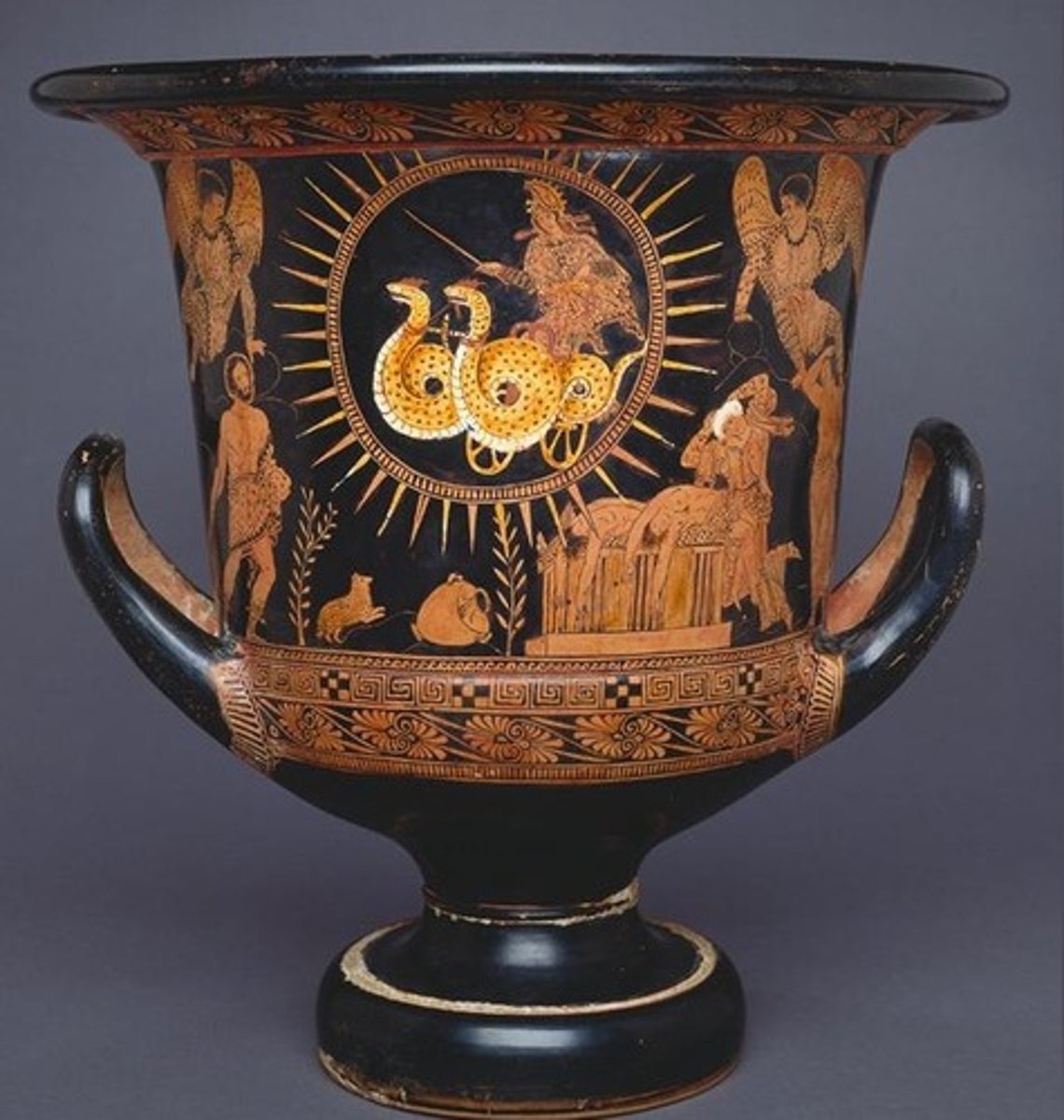
What's the significance of 'the red-figure Calyx Krater depicting Medea's escape' prescribed source?
A painted scene of Medea's escape seems to portray the use of the crane and wheel platform.

What's the description of 'the red-figure Calyx Krater depicting Medea's escape' prescribed source?
- Medea flies above the human scene of her 2 dead sons on a chariot drawn by dragons, circled by the sun.
- On either side, winged women- possibly furies- look down.
- In the corner there's a nurse and tutor raising their hands in mourning.
- Jason on the left is bare-chested like a hero (which is unlike tragedies) and is locking eyes with Medea.
- The sons are slumped over the wheel platform that's made to look like an altar and Medea is most likely help up by a crane.
- Yet this differs greatly from Euripides' play, as in it there were no furies or dragons.
- Medea also takes the boys with her so Jason can't bury them. - This could be artistic licence, or a different version of the play, but we shouldn't assume painted scenes are fully accurate of the stage.
- There's nothing in this to indicate it's a performance.
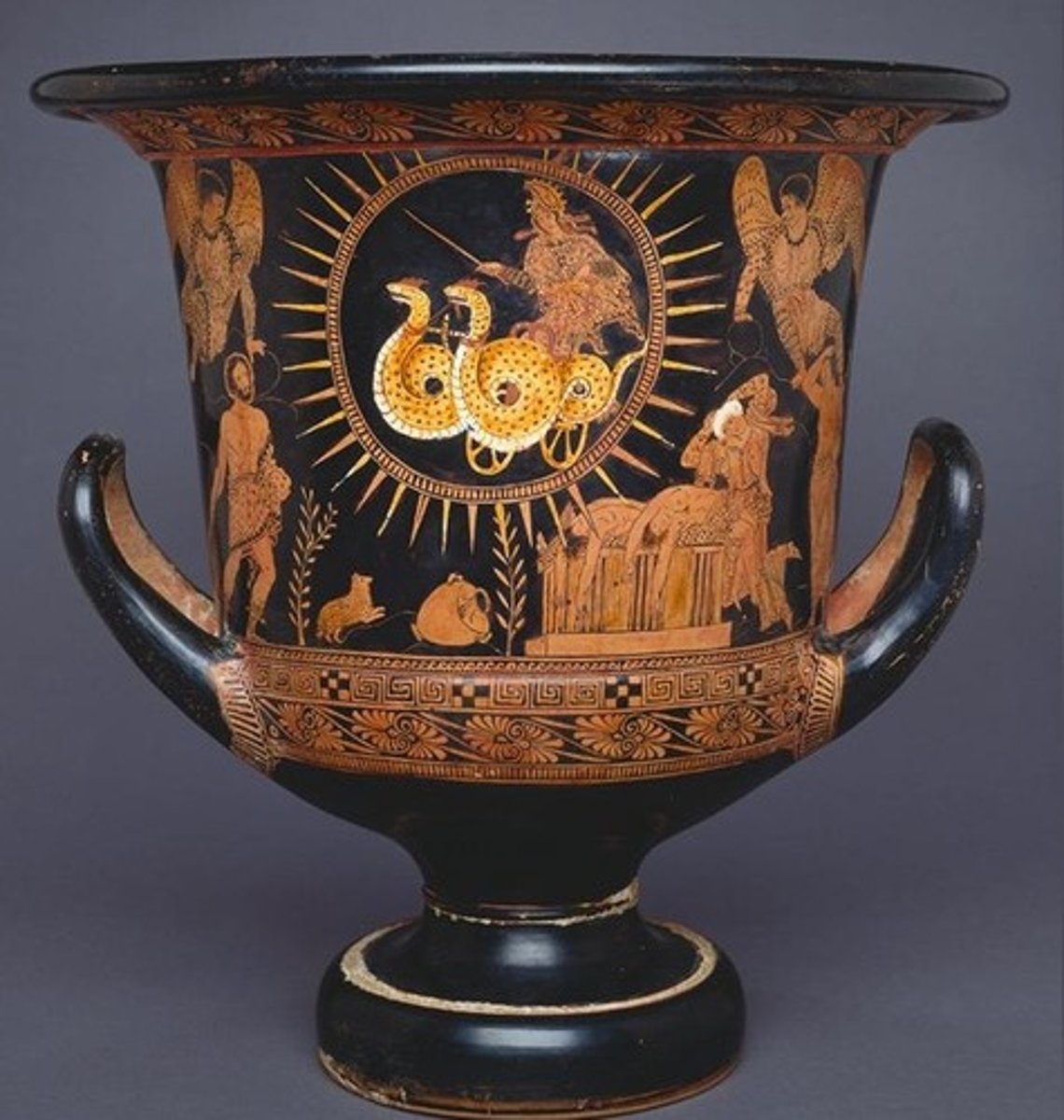
How did vase making/the depiction of tragedy on vases change over time?
- Athenians made many vases in the late 6th century, but from 400 BC there was a decrease
- Initially, they were black figure (red-background)
- By the 5th century they were red-figure (black-background) as it allowed for more detail and natural scenes.
- During the height of tragedy (500-406 BC) only 2 paintings exist to show a tragic performance.
- The Pronomos Vase from 400 BC shows up people in costumes off stage
- After the decline of Athenian pottery, there are still many
that depict Greek theatre from the Greek cities of Southern Italy.
- This suggests that the works of Athenian playwrights were well known and reperformed, and they can give us significant details of comic performances (including staging and costumes.) Such as: The red-figure bell krater- The Thesmophoria Vase
Who is the artist of the 'red-figure bell krater- The Thesmophoria Vase' prescribed source
The Schiller Painter
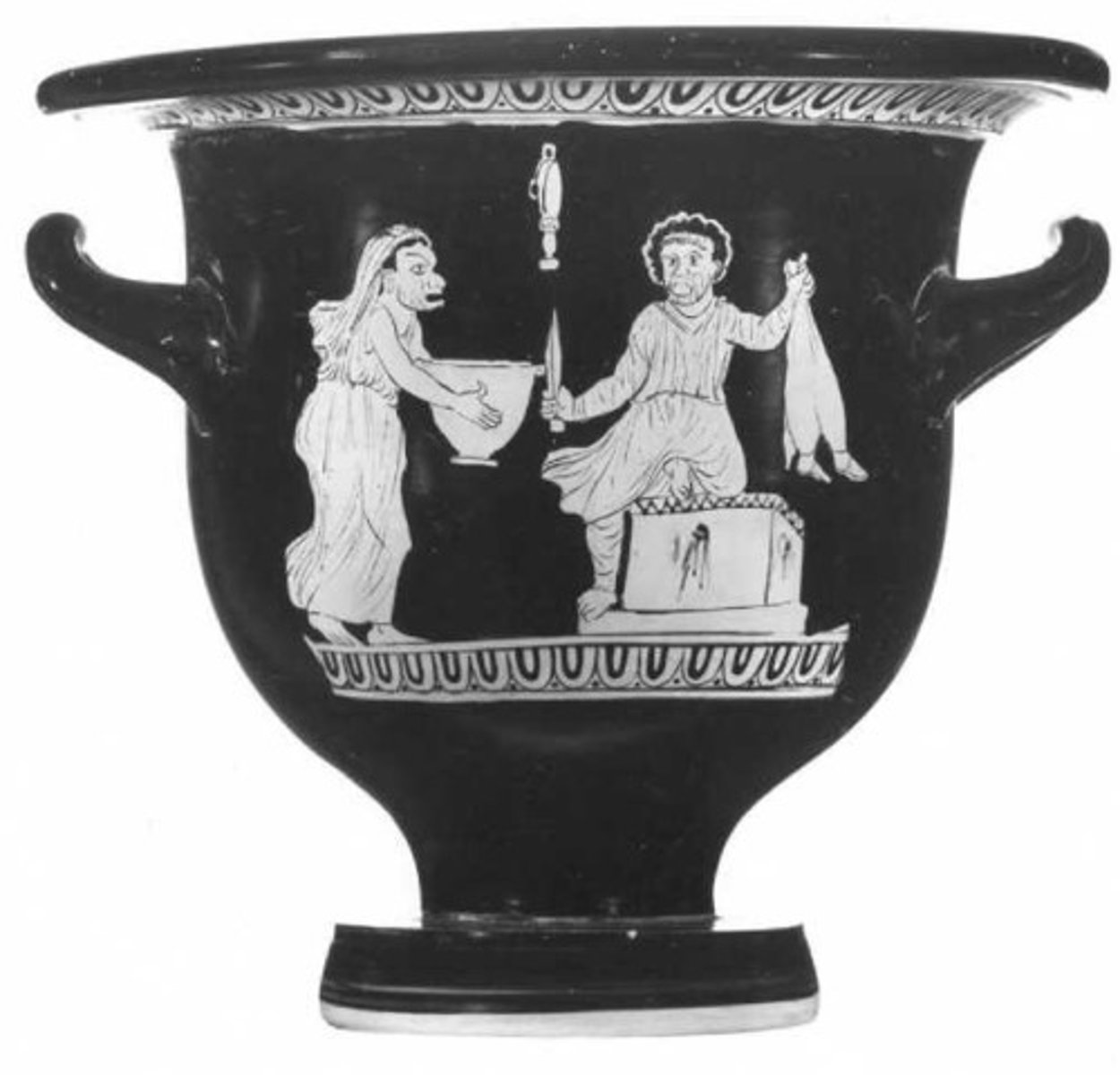
What object is the 'red-figure bell krater- The Thesmophoria Vase' prescribed source
Red figure bell krater (mixing bowl)
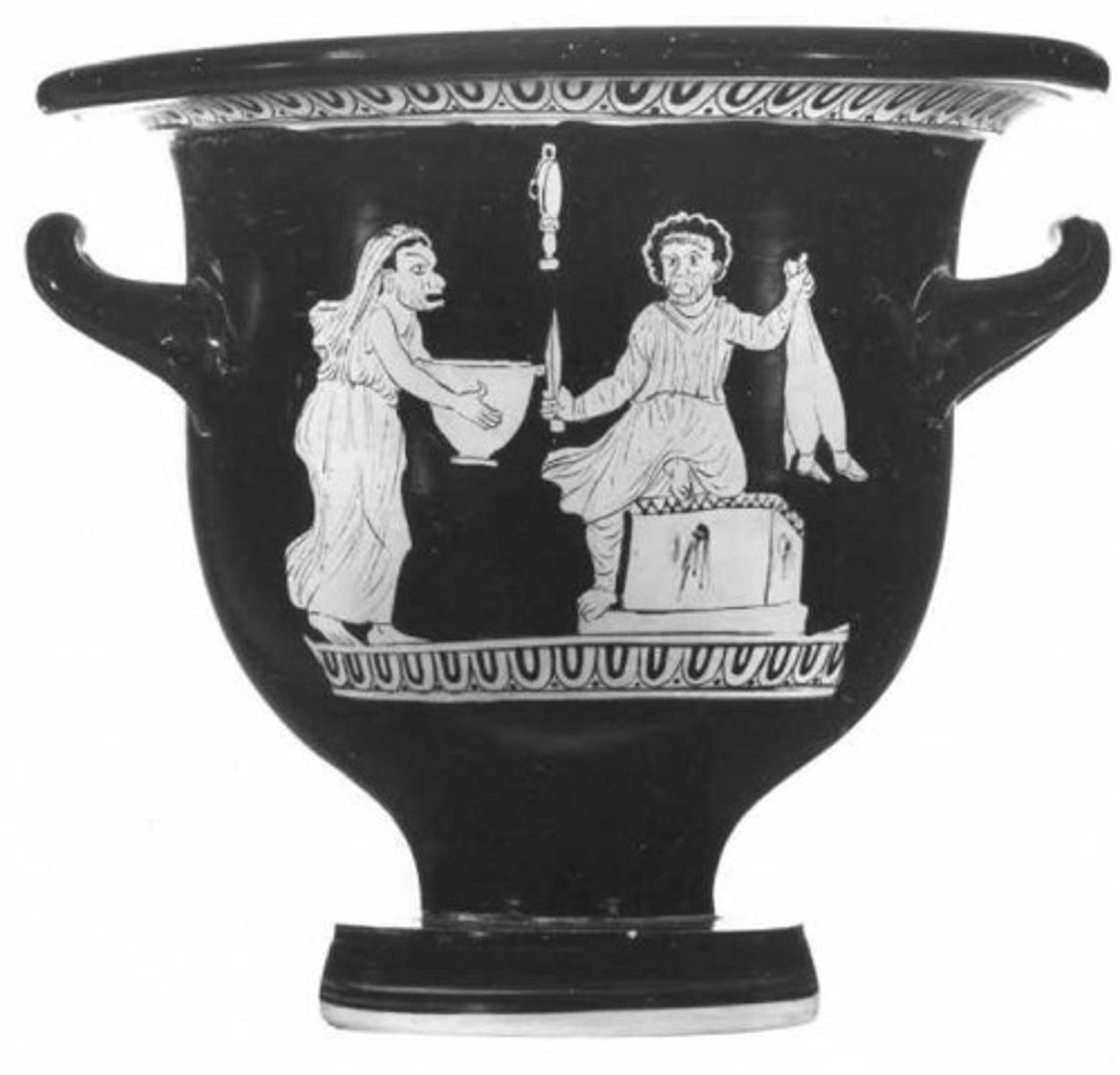
Where is the location of the 'red-figure bell krater- The Thesmophoria Vase' prescribed source
Martin von Wagner Museus, Wurzburg
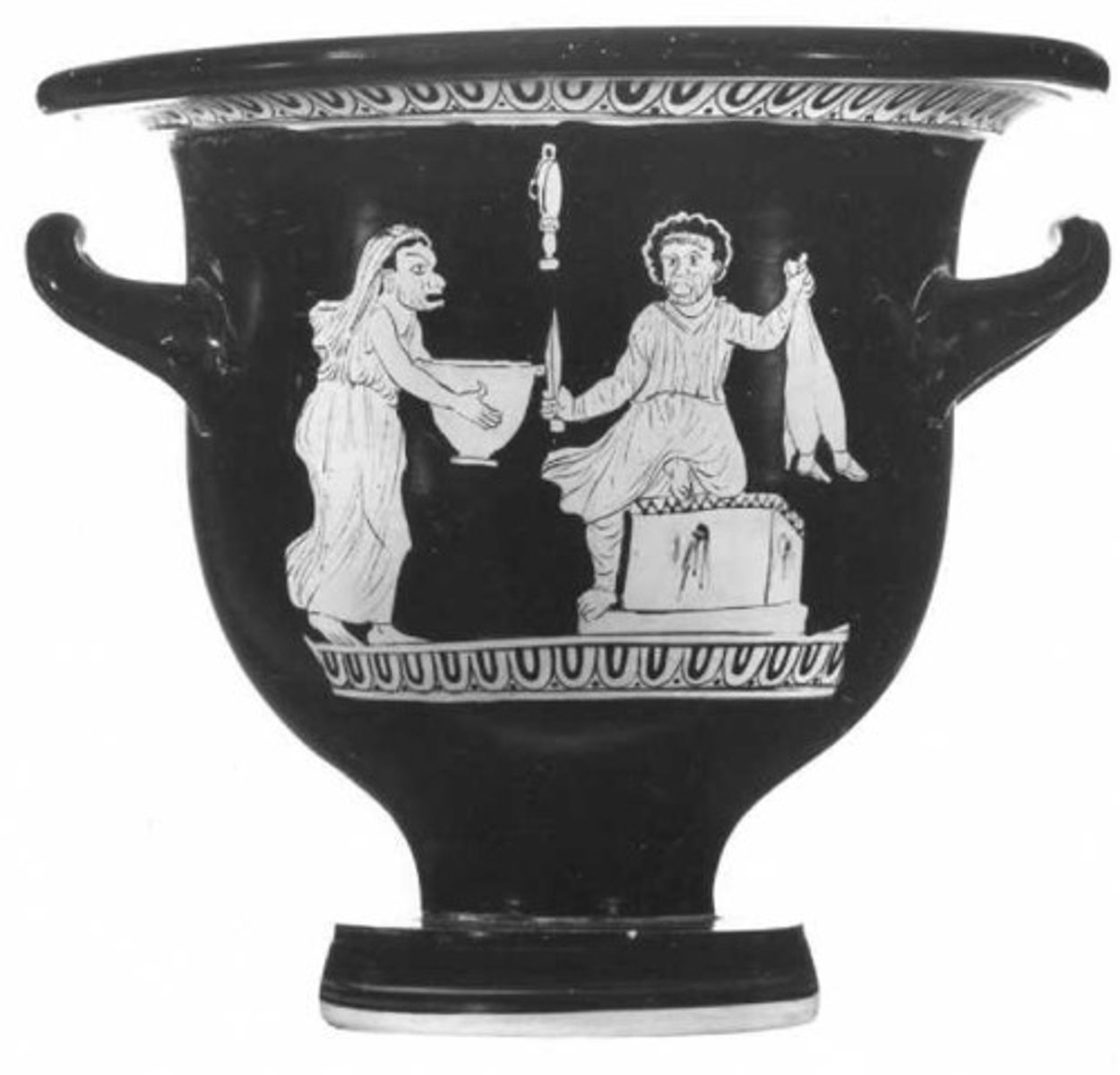
What is the date of the 'red-figure bell krater- The Thesmophoria Vase' prescribed source
380-370 BC (Thesmophoria was presented in 411 BC)
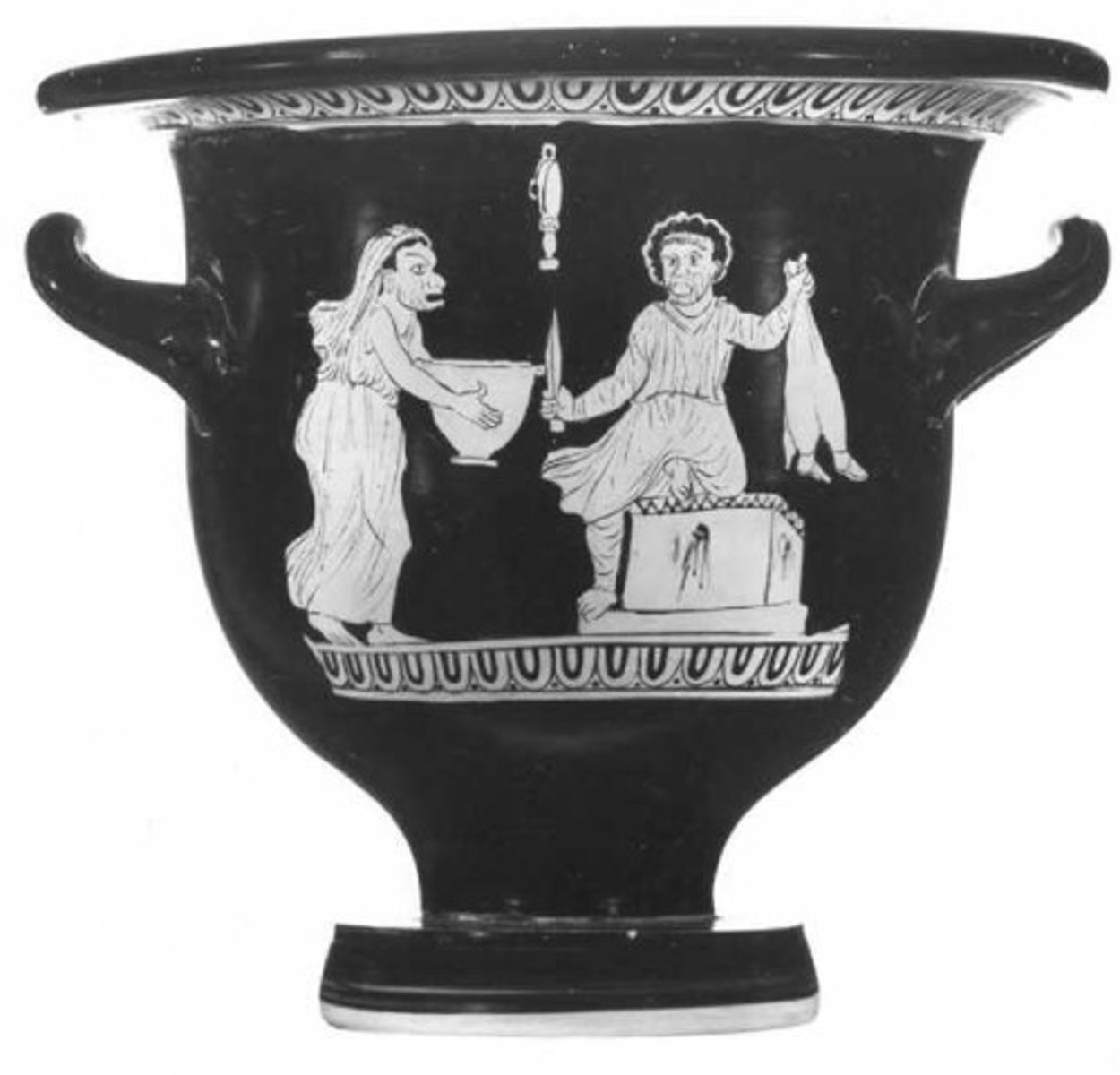
What is the significance of the 'red-figure bell krater- The Thesmophoria Vase' prescribed source
- South Italian vase showing a scene from an Aristophanes' comedy.
- This suggests Athenian comedy was known, and the play must have been reperformed in at least one southern Italian theatre. - Italy must also have known of Euripides too because he's a character in the play!
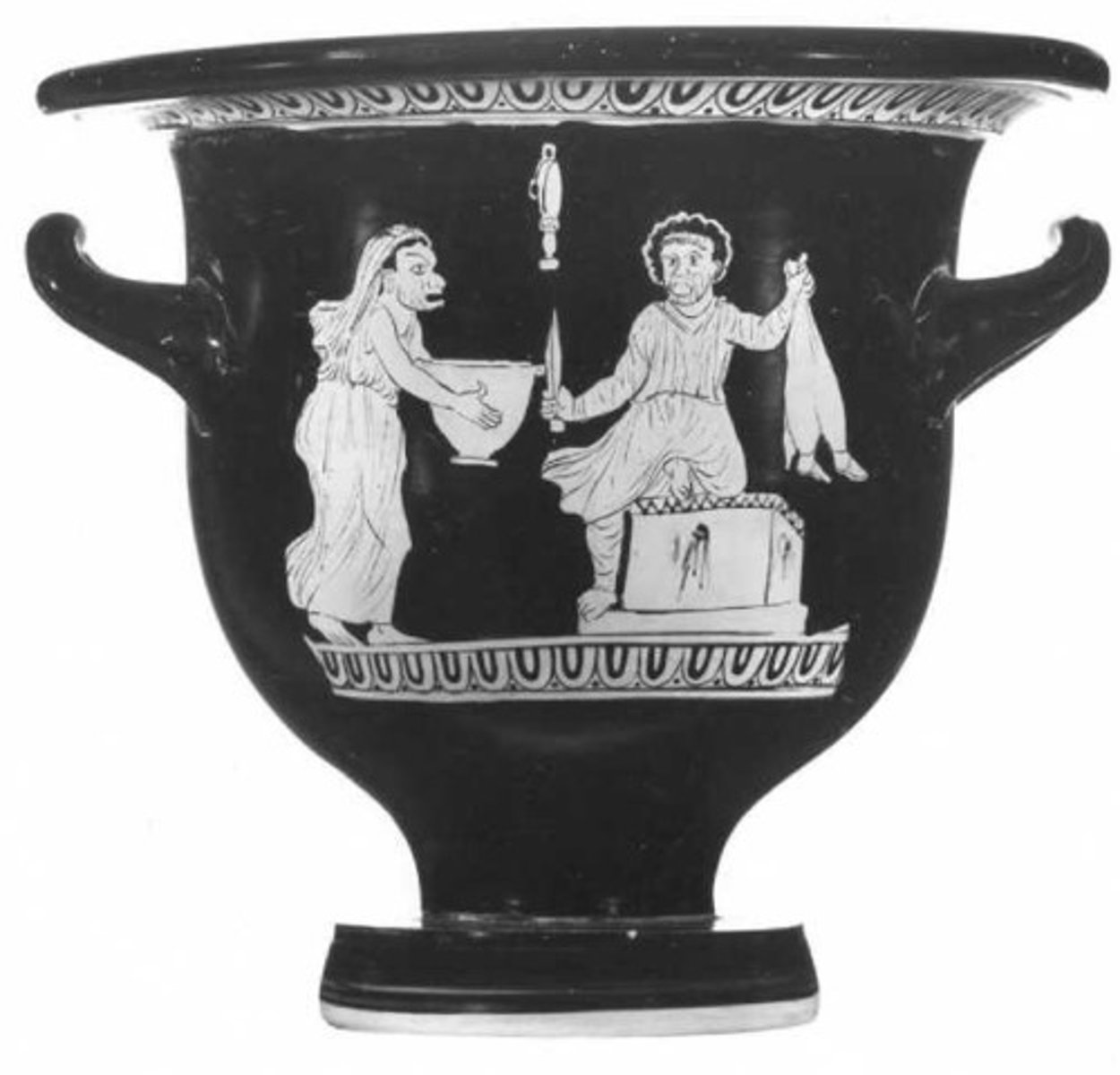
What is the description of the 'red-figure bell krater- The Thesmophoria Vase' prescribed source
- It depicts Euripides relative snatching the 'baby' from one of the women, going to the alter and threatening to kill it with a knife.
- The baby is a wineskin, so she rushes up with a bowl so there's no spillage.
- The costumes and small details match the play.
- In the play, there's a dressing scene where he's shaved and given a women's headband. This headband is visible in the source.
- Most men in Southern American comic vases were bearded, and this guy is shaved!
- The mirror from the play is also suspended in the source above the centre of the scene.
- We can't say it's completely accurate though
